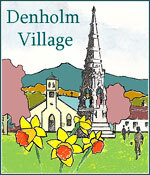The Early Church
There is no record of a Church in Denholm before the 17th century and it is thought that the villagers must have worshipped at Cavers. It is just possible that there was an early chapel at little Cavers as " Maurice Lovell, parsonne of little Cavers" is recorded in the Ragman Rolls of 1296.
All Church lands and possessions on the Cavers estate had been granted to the monks of Melrose about 1358 by William, Earl of Douglas. The "Dominical" (Church) lands of Denholm referred to in the chapters during the time of the Cranstouns were probably at Honeytown by the Stonyburn, both known today as Honeyburn. The house at Honeyburn still has a cross on the north west Gable. A possible explanation for the naming of the Cannon Gate is that the monks used to come that way into Denholm on their way to Church properties on Cavers land. They are said to have had a an apiary at Honeyburn where they came to collect their honey.
The Covenanters
In 1658, as we have seen, Denholm was reunited to the Cavers estate by Sir Archibald Douglas. The new Laird and his family were fervent Covenanters, bitterly opposed to the bishops and Anglican forms of worship which Charles 1st had tried to force upon the Presbyterian Church of Scotland.
In 1662 the Douglas's refused to admit a curate sent by the official Church and representatives from Jedburgh were stoned by the women of Cavers. After this the Covenanters in this area were persecuted by the law and had to resort to to secret conventicles and prayer meetings in hidden places such as Pedens pulpit on Ruberslaw and Pedens Vale in Denholm Dean (just below the ruined cottage).
In 1690 the Presbyterians were finally recognised as the established Church in Scotland but the strictest Covenanters would not join it. A group of them known as the Cameronians formed their own congregation in Denholm under the patronage of the Douglas family.
The Cameronian Chapel
We do not know what building they used until about 1740 when the old Cameronian chapel was built with the preachers house adjoining. The site, behind Poplar Nook on the Small Green, was given by the Laird. The Chapel had seating for 230 people and had three pulpits, the lowest one for the precentor. Seats and pulpits were later covered in red plush and the high pulpit ran the full length of the building.
The Douglas family continued to reject the Established Church in their home village of Cavers and worshipped with the Cameronian “Dissenters” or “Independents” all through the 18th and 19th centuries. They would walk to Denholm and back every Sunday as it was held to be wrong to ride a horse on the Lord’s Day. Their route through the Dean became known as the “Kirk Walk”. Presumably any Denholm Villagers who belonged to the Established Church would take the same path to and from worship to Cavers – but in the opposite direction.
By the end of the 19th century the Cameronian or Independent Chapel was also called the Meeting House or the Mission Hall, Services were held only every second Sunday and on summer evenings. It closed some time in the 1920’s and was used for a while as a smithy. It was finally demolished after the 2nd World War but the Preacher’s house is still standing and is known as Elmbank.
The Free Church
The present church in Denholm was built as a Free Church in 1844 at the time of the Disruption. This had taken place the previous year when two fifths of the Scottish clergy broke away from the Established Church. They were no longer prepared to tolerate private patronage and interference from civil authorities in church matters.
The people of Denholm built their new church with money they raised themselves. The site was made available by the Laird. Presumably he was pleased to support the new Free Church because it defied the Established Church which his family had long opposed. Some of the stones were collected by the village women from the river and rough undressed stone work can be seen in a section of the north wall near the entrance to the Pitt Memorial Hall. The Hall was built in 1892 in memory of the Rev. Thomas Pitt who died in service as a minister.
Two of the longest serving ministers were the Rev. James McClymont who held office for 40 years from 1847 to 1886 and the Rev. John Smith who was minister for 36 years from 1892 until his death in 1928. The original manse was at Townhead at the top of what came to be known as the Manse Brae. The house is now called Beechlands.
The United Free Church (as it became known in 1900) was known locally as the Kirk. Chapel and Kirk appear to have coexisted well until the Chapel finally closed in the 1920’s. On alternate Sundays the Independent congregation would worship at the Kirk and their Preacher, William Ramsay, also served as an elder and seat rent officer for the Kirk.
The United Free Church in Denholm rejoined the Established Church, now the Church of Scotland, in 1929 under the Presbytery of Jedburgh. But some who had been in the habit of traveling to Cavers or Minto continued to do so throughout the 1930’s. In 1963 it was linked with the Parish of Bedrule and in 1975 with Minto.
The House of Brethren
At the end of the 19th century there was also a House of the Brethren in Denholm. This was the cottage which is now the west half of the Neuk in Eastgate. Mill workers used to come from Hawick and Jedburgh to worship there.
Congregational Church
There was a Congregational Church in Denholm from 1826-1876 supplied by ministers Francis Dick, 1826-35; Robert Wilson, 1835-43; John Spence, 1844-45; John McRobert, 1846-76.
